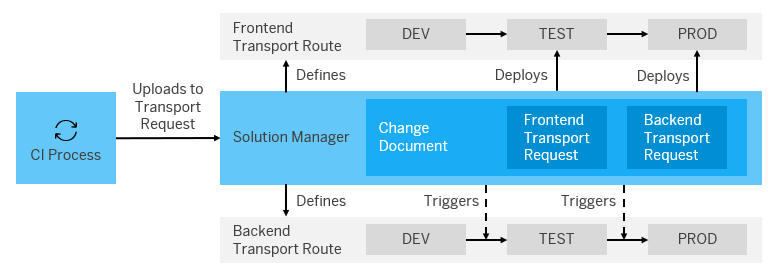Build and Deploy Hybrid Applications with SAP Solution Manager¶
Set up an agile development process with Jenkins CI, which automatically feeds changes into SAP Solution Manager.
Prerequisites¶
- You have installed the Java Runtime Environment 8.
- You have installed Jenkins 2.60.3 or higher.
- You have set up project “Piper”. See README.
- You have installed SAP Solution Manager 7.2 SP6. See README.
- You have installed the multitarget application archive builder 1.0.6 or newer. See SAP Development Tools. Note: This is only required if you don't use a Docker-based environment.
- You have installed Node.js including node and npm. See Node.js. Note: This is only required if you don't use a Docker-based environment.
Context¶
In many SAP development scenarios, it is vital to synchronize both backend and frontend deliveries. These deliveries are typically an SAPUI5 application and an ABAP backend from which it is served. The SAPUI5 parts are often developed using agile practices and use Continuous Integration pipelines that automatically build, test, and deploy the application.
Note
This scenario description is an example. You can apply the process to other scenarios and component sets, as well.
In this scenario, we want to show how an agile development process with Jenkins CI can automatically feed changes into SAP Solution Manager. In SAP Solution Manager, all parts of the application stack come together and can be subject to classic change and transport management.
The basic workflow is as follows:
-
The pipeline scans the Git commit messages for a line like
ChangeDocument : <changeDocumentId>, and validates that the change is in the correct statusin development. For more information, see checkChangeInDevelopment. An example for the commit message looks as follows:Fix terminology in documentation Terminology must be consistent with official channels. ChangeDocument: <Your Change Document ID>Note: The blank line between message header and message description is mandatory.
-
To communicate with SAP Solution Manager, the pipeline uses credentials that must be stored on Jenkins using the credential ID
CM. For more information, see checkChangeInDevelopment. - The required transport request is created on the fly. Note: The change document can contain various components (for example, UI and backend components).
- The changes of your development team trigger the Jenkins pipeline. It builds and validates the changes and attaches them to the respective transport request.
- As soon as the development process is completed, the change document in SAP Solution Manager can be set to status
to be testedand all components can be transported to the test system.

Hybrid Application Development Workflow
Example¶
Jenkinsfile¶
@Library('piper-lib-os') _
node() {
stage('prepare') {
checkout scm
setupCommonPipelineEnvironment script:this
transportRequestDocIDFromGit( script: this )
checkChangeInDevelopment script: this
}
stage('buildMta') {
mtaBuild script: this
}
stage('uploadToTransportRequest') {
transportRequestCreate script: this
transportRequestUploadSOLMAN script:this
transportRequestRelease script: this
}
}
Configuration (.pipeline/config.yml)¶
#Steps Specific Configuration
general:
changeManagement:
endpoint: 'https://<backend-system>/sap/opu/odata/sap/AI_CRM_GW_CM_CI_SRV'
credentialsId: 'CM'
type: 'SOLMAN'
steps:
mtaBuild:
buildTarget: 'NEO'
transportRequestCreate:
developmentSystemId: '<value for developmentSystemId>'
transportRequestUploadSOLMAN:
applicationId: 'HCP'
Parameters¶
For the detailed description of the relevant parameters, see: